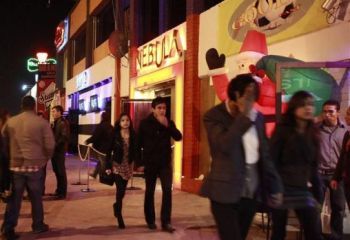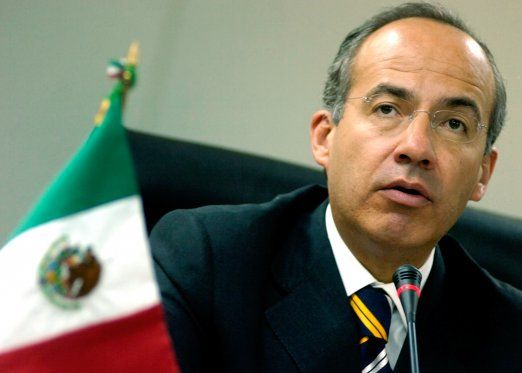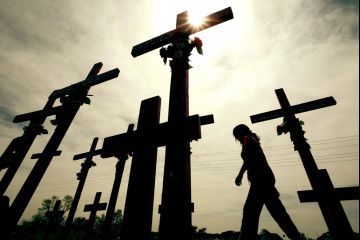
Publisher:
Bonnie King
CONTACT:
Newsroom@Salem-news.com
Advertising:
Adsales@Salem-news.com

~Truth~
~Justice~
~Peace~
TJP
Mar-22-2012 21:45

 TweetFollow @OregonNews
TweetFollow @OregonNews
Is Ciudad Juarez Turning Around?
Kent Patterson for Salem-News.com“The perceived risk is smaller than before, probably because less violent acts are happening than before."
- Miguel Gomez of business organization 'La Red'.
 Nightlife in Ciudad Juarez is making a comeback. Courtesy: latino.foxnews.com |
(LAS CRUCES, NM) - More than four years after a so-called narco war exploded and then devastated Ciudad Juarez, a different atmosphere is perceptible on the streets of the border city. While still very high by historic standards, the rate of murders is way down from the height of the killing two years ago. Some restaurants are doing a brisk business, and locals are reviving the once-famed night life in the Avenida Juarez and Pronaf districts. Smiles come quicker and last longer.
Hunkered down for weeks in city hotels in order to avoid assassination squads, municipal police were permitted this week to go home after their shifts ended.
And perhaps in a sign of the times, an old building that long housed a restaurant on the corner of Avenida Juarez and 16 de Septiembre in downtown Juarez but shuttered its doors as violence reached a fever pitch and the economy crumbled is stirring to life. A renovation of the building’s interior is underway while signs plastered on the windows solicit new restaurant workers.
“We note that people feel a little more secure,” said Ana Fierro, the coordinator of a new citizen initiative dedicated to training Ciudad Juarez’s future leaders. “People are going about their routine business-restaurants, kids' activities…”
Cautious optimism might define the popular mood in Ciudad Juarez in the spring of 2012.
 Mexican President Felipe Calderon. Photo courtesy: topnews.in |
At the federal level, the Calderon administration is claiming important successes in Ciudad Juarez. In the aftermath of the public outcry over the slaughter of 15 young people at a house party in the Villas de Salvarcar neighborhood back in January 2010, the Calderon government rolled out its “Todos Somos Juarez” program directed at a city on the brink. Since the massacre, different federal agencies have spent millions of dollars on hundreds of temporary jobs, constructing libraries and other facilities, rehabilitating parks and public spaces and enrolling low-income residents in the government’s universal health care program.
In the run-up to the March 30 election campaign ban on government publicizing of public works, the Calderon administration saturated Mexican electronic media with spots on the Felipe Angeles Community Center. Built across the Rio Grande from El Paso’s old Asarco smelter, the new center sponsored recreational and educational programs as part of a broader community intervention strategy. The Calderon administration recently claimed that violence had dropped dramatically in the Felipe Angeles neighborhood, plummeting from 112 murders in 2010 to 12 in 2011.
Authored by local journalist Julian Cardona, an article posted on New Mexico State University librarian Molly Molloy’s Frontera list calculated that 10,185 people were murdered in the municipality of Ciudad Juarez from 2008 to 2011. Molloy estimated another 216 victims were slain between January 1 and the first four days of March of this year.
 Photo courtesy: globalpost.com |
If the current murder rate holds, the level of homicide will dip below 2008 numbers by the end of 2012. On many recent days, more people have been murdered in Monterrey, Chihuahua City or Acapulco than in Ciudad Juarez, which not long ago, was considered the most dangerous place in Mexico and perhaps even the world.
But according to one knowledgeable source who preferred to remain anonymous, the decline in local violence is linked to the emergence of the group around fugitive drug lord Joaquin “El Chapo” Guzman as the dominant force in Ciudad Juarez, while rivals associated with the old Juarez cartel lick their wounds, reorganize and contemplate the next moves. Sporadic violence could be part of a mopping-up operation.
“It got cleaned out,” the source said of the logic and outcome of underworld business competition in Ciudad Juarez. “It had to…you tear it down and build a new structure.”
Across the border in El Paso, Miguel Gomez presides over the board of La Red, an organization currently consisting of 40-60 Mexican business people who began relocating to the U.S. when the violence heated up a few years back. The new wave of immigrants transformed the landscape of El Paso. On the west and east sides of the sprawling city, many businesses with a historic Juarez presence suddenly opened their doors to U.S. customers and dollars.
 |
Founded in 2010, La Red was formed as a personal support and professional advancement network for entrepreneurs fleeing the killing, kidnapping and extorting that ripped their city apart. La Red’s members hailed from the smaller business class that bore the brunt of the violence, Gomez told Frontera NorteSur in a phone interview.
More recently, however, the relocation trend has dissipated. “It has slowed. We have seen less people coming over since things have pretty much started to improve on the other side,” Gomez said.
Police corruption and the collapse of the rule of law were central elements of Ciudad Juarez's crisis. Numerous members of security forces-local, state and federal- were implicated in criminal activities and human rights abuses that included robbery, kidnapping, extortion, torture, rape and murder. Former Mayor Jose Reyes Ferriz (2007-2010) announced a purging of the local police, which continued under the subsequent municipal administration of Hector “Teto” Murguia and his controversial police chief, former military man Lt. Col. Julian Leyzaola.
Residents and close observers have mixed opinions about the current state of public safety, law enforcement and criminal justice.
“There’s still risk over there,” Gomez said. “The perceived risk is smaller than before, probably because less violent acts are happening than before."
Gomez contended that there have been improvements in municipal and state law enforcement, pointing to the detentions of multiple bands of kidnappers as well as a Chihuahua state law that now slaps kidnappers and extortionists with life sentences.
Ana Fierro, coordinator of the Leaders Network, said the citizenry has “more confidence” in the local cops but matters of corruption still need to be addressed.
 |
Elizabeth Flores, director of Pastoral Obrera, the Roman Catholic Church’s social and labor advocacy arm, offered a critical assessment of the public safety question. “There are less murders but this isn’t related to the improvement of security, ” Flores said in an interview. “We don’t know if it’s just that the cartels aren’t disputing the plaza or if the police are improving. There are no investigations to tell us that.”
What’s more, no significant advances are evident in bringing the murderers of thousands of people to justice or shedding light on the slayings and disappearances of young women, including the dozens of unidentified female bodies stacked up in the local morgue, Flores argued.
Serious crimes like carjacking and extortion remain problems, she said, while unemployment haunts the city. The veteran community activist insisted that “all the crimes have to go down,” but the public is in the dark about crime rate tendencies other than murder. Meanwhile, illegal drug use and addiction are on the rise, Flores said.
Economically, conflicting signals abound. The maquiladora industry trade journal Juarez-El Paso Now reported in its current edition that the export manufacturing sector added 7,207 jobs in the first month of the year, while the daily Norte quoted Maquiladora Association President Jose Luis Armendariz as saying that another 20,000 factory jobs could be added by the end of 2012. On the other hand, El Diario newspaper reported this week that the key construction industry remains sunk in its worst crisis in decades while some hotels could close in the coming months if tourism continues on the skids.
La Red’s Miguel Gomez said members of his organization will have to make personal decisions whether to return or reinvest in Ciudad Juarez. Each situation is different, he said.
“I’m a capitalist. As a capitalist, if I have an opportunity to set up a business in a place and it’s profitable I’ll stay here,” Gomez said of the motivations driving members’ decisions.
Immigration and business will be the focus of a La Red event scheduled for early in the evening of April 13 at El Paso’s Hilton Garden Inn, he added.
As Ciudad Juarez climbs its way out of a long crisis, different actors are positioning themselves for the city’s future.
Based out of the Human Leadership Center in Ciudad Juarez, the Leaders Network is cultivating the next generation of the city’s movers and shakers. According to Fierro, the goal is to link at least 40 existing non-governmental organizations working on education, poverty and other issues with each other, the public and government officials to address problems in a comprehensive manner.
Among others, the initiative is endorsed by businesses including Auto Value, Grupo Intelia and Grupo Summa, as well as the Pact for Juarez, a good government proposal affiliated with the Juarez Strategic Plan.
With only about one in ten residents presently participating in organized community and civic activities, an urgent need exists to greatly increase public engagement, Fierro said.
“We think that civil society not government or the authorities will transform Juarez,” she maintained.
Frontera NorteSur: on-line, U.S.-Mexico border news
Center for Latin American and Border Studies
New Mexico State University
Las Cruces, New Mexico
 |
 |
 |
 |
Articles for March 21, 2012 | Articles for March 22, 2012 | Articles for March 23, 2012


Quick Links
DINING
Willamette UniversityGoudy Commons Cafe
Dine on the Queen
Willamette Queen Sternwheeler
MUST SEE SALEM
Oregon Capitol ToursCapitol History Gateway
Willamette River Ride
Willamette Queen Sternwheeler
Historic Home Tours:
Deepwood Museum
The Bush House
Gaiety Hollow Garden
AUCTIONS - APPRAISALS
Auction Masters & AppraisalsCONSTRUCTION SERVICES
Roofing and ContractingSheridan, Ore.
ONLINE SHOPPING
Special Occasion DressesAdvertise with Salem-News
Contact:AdSales@Salem-News.com



Terms of Service | Privacy Policy
All comments and messages are approved by people and self promotional links or unacceptable comments are denied.
[Return to Top]
©2026 Salem-News.com. All opinions expressed in this article are those of the author and do not necessarily reflect those of Salem-News.com.